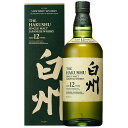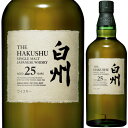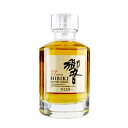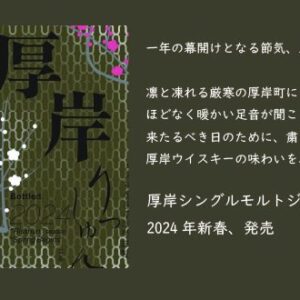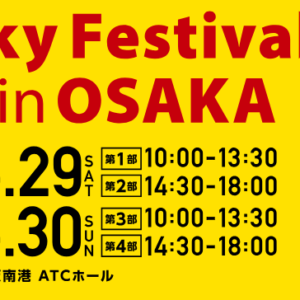Established in 1973. Suntory’s second distillery located at an altitude of 700 meters above sea level.
1.Outline
Suntory’s second distillery, established under the leadership of Suntory’s second president “Keizo Saji” to commemorate the 50th anniversary of “Yamazaki Distillery”.
The distillery is located at about 700 meters above sea level at the foot of Kai Komagatake in the Southern Alps, and is one of the highest distilleries in the world.
The distillery aims to produce different types of sake from the Yamazaki distillery, and the sake produced here is different from that of the Yamazaki distillery, being gentle and clean.
The distillery boasts the largest site of any whiskey distillery in Japan, covering 825,000 square meters, or about 64 times the size of the Tokyo Dome.
It is one of the largest distilleries in the world.
The distillery is surrounded by forests, and 83% of the site is undeveloped to protect the natural environment.
It is also called the “forest distillery” because of the way it is surrounded by forests.
2.Basic Information
2-1. Owner
Suntory (Suntory Holdings Ltd.)
2-2. Location
408-0316, Japan
2913-1 Torihara, Hakushu-cho, Hokuto City, Yamanashi Prefecture
2-3. Access
Bus】 【Bus
Free shuttle bus service is available from JR Kobuchizawa Station.
Car】 【Car
20 minutes by car from Chuo Expressway IC Kobuchizawa
2-4. Start of operation
1973 (Showa 48)
2-5. Main Products
Single malt Hakushu 12years old

2009 IWSC (International Wine and Spirits Competition) Gold Medal
2010 IWSC Gold Medal
Gold Medal at SWSC (San Francisco World Spirits Competition) 2011
2012 IWSC Gold Medal
Gold Medal at ISC (International Spirits Challenge) in the same year
Gold medal at the SWSC in 2013
Gold medal at the SWSC in 2014
2016 SWSC Best Gold Award
More items here.
3.Tours and Visitor Centers

Image credit: PRTIMES
.
There are two types of courses: “Hakushu Distillery Manufacturing Tour (90 minutes, 3,000 yen) ” and ” Hakushu Distillery Manufacturing Tour Premium (130 minutes, 5,000 yen )”.
Please note that like the Yamazaki Distillery, this tour is offered by lottery.
Click here to make a reservation.
https://reserve.suntory.co.jp/regist/switch/00051c0001CJe69uI7/courseList?wr=suntory_factory&p=hakushu_01&k=176014407c 55557e600017166817402052534066544642331243215d5b116600421a624047205c5a45350a4512361448765400116007454531121370 5157403204114062444676073d1761501646621613
3-1. Gourmet Information in the Surrounding Area
After stopping by Hakushu Distillery, you can enjoy a gourmet meal.
3-2. Sightseeing Lodging
Hakushu Distillery is only about two hours away from Tokyo, but if you go to the trouble of visiting the distillery, there is no excuse not to enjoy the local sightseeing and hotels as well.

4.Manufacturing specs
Long fermentation in wooden fermentation tanks and direct distillation using traditional methods.
In addition, Nikka Whisky introduced a café-type continuous distillation machine in 2013, which was introduced early on in the company’s history.
It is now possible to produce grain and rye whiskey.
The Suntory Natural Water Southern Alps bottling plant is also located on the same site.
| Production Volume | Volume of production |
| Preparation water | Underground water (soft water) with a hardness of approximately 30 degrees polished by granite in the Kaikomagatake water system of the Southern Alps |
| Malt | Imported malt from England (phenol value 0~40ppm), peat from England |
| Brewing quantity | 10~18 tons per batch |
| Malt mill | Porteous 4 roller mill |
| Saccharification tank | Stainless steel fluroytartan made by Miyake Seisakusho / 130,000 liters Other cookers for grain whiskey |
| Wort volume | 55,000 liters |
| Fermentation tanks | 18 Oregon Pine vats/75,000 liters 6 stainless steel fermenters for grain whiskey |
| Pot still | (1) First distiller (heated by direct gas fire for 7~8 hours) Made by Macmillan and Miyake Seisakusho Straight type 5 units / Lantern type 3 units Capacity 8,000 to 23,000 liters (2) Redistillator (steam coil heating for 12 hours) Made by Miyake Seisakusho Straight type 6 units Lantern type 2 units 4,000-13,000 liter capacity Other Forsyth two-tower continuous distillation machine |
| Cooling system | 7 units of first distillation shell & tube / 1 unit of worm tab Shell and tube for redistiller |
| Bottling facilities | None |
| Aging cellars | 18 rack type / 19 Omi aging cellars |
5.Ripening environment
One of the differences from the Yamazaki distillery is that the Hakushu distillery owns a barrel mill.
The barrels used for aging are mainly American white oak bourbon and hogshead barrels. (Reassembled bourbon barrels)
We also do our own “recharging,” which is the process of browning the barrels.
The degree of browning is set in detail by the craftsman according to the purpose of the browning.
Because the temperature is much cooler and less humid than at the Yamazaki distillery, the aging process proceeds more slowly.

Image credit: PRTIMES
.

Image credit: Hakushu Distillery
6.Distillery Story
6-1. History
| 1973 1973 (Showa 48) |
The first Hakushu distillery was established in Hakushu-machi, Yamanashi Prefecture. At the same time, the Bird Sanctuary was established. |
|---|---|
| In 1977, the first Bird Sanctuary was established in Hakushu-machi, Yamanashi Prefecture. 1977(Showa 52) |
The second Hakushu distillery was completed. The 12 distillers of the first Hakushu distillery were added. With a total of 44 fermentation tanks and 24 distillers, production doubles, making it the largest distillery in Japan. |
| 1979 (1979) |
Whiskey Museum” opened. |
| 1981 (Showa 54) (Showa 56) |
Hakushu Plant No. 3 opened. Twelve fermentation tanks are made of wood, and 12 smaller distillers are installed for direct-fired distillation. Production of Hakushu No. 1 and No. 2 is suspended. |
| 1983 (1983) |
Completed construction of Yatsugatake Aging Cellar in Hokuto City, Yamanashi Prefecture. |
| 1988 (Showa 58) (1988) |
Hakushu No.3 plant renamed Hakushu East Distillery (current Hakushu Distillery) and opened to the public. Hakushu 1st and 2nd plants become Hakushu West Distillery, but distilling operations are suspended. Hakushu No. 1 remains, but most of No. 2 is dismantled. |
| 1992. (Heisei 4) |
Suntory Whiskey Shirokaku is released. |
| 1994 1994 (Heisei 6) |
Hibiki 21nen”, “Pure Malt Hakushu 12nen” and “Old Mild & Smooth” put on sale. |
| 1996 (Heisei 6) 1996 (Heisei 8) |
Minami-Alps Natural Water Hakushu Plant, a mineral water production plant, completed. Reserve 10 Years” released. |
| 1997 1997 (Heisei 9) |
Developed and introduced an anaerobic total treatment system for distillation residual liquid treatment. New “Royal 12years” and “Royal 15 years” were put on the market. |
| 2003 2003 (Heisei 15) |
Hakushu distillery is registered as the 120th malt whiskey distillery by the Scotch Malt Whiskey Society (SMWS). |
| 2004 (Heisei 15) (Heisei 16) |
Vintage Malt Hakushu 1981, 1982, 1985, 1987, 1988, 1990, 1993″ was released. Sales of Owner’s Casks begin. Release of “Pure Malt Whisky Hokuto 12nen” and “Hibiki 17nen 50.5”. |
| 2006 2006 (Heisei 18) |
Single Malt Hakushu 18nen” put on sale. |
| 2007 (Heisei 18) 2007 (Heisei 19) |
Kakubin (Black 43°)” and “Old 43 Premium Rich” released to coincide with the 70th anniversary of Kakubin |
| 2008 (Heisei 19) 2008 (Heisei 20) |
Released “Hakushu 25 Year Old”, “Hakushu Distillery 1996”, “THE CASK of HAKUSHU Heavy Peated Malt 1993”, and “Spanish Oak Botacorta 1993”. Renewal release of “Old”. |
| 2009 2009 (Heisei 21) |
Suntory Holdings Ltd. is established as a pure holding company. Hakushu Hefty Peaked 2009″ is released. |
| 2010 (Heisei 22) |
Started construction of grain whiskey production facility. Hakushu Heavy Peated 2010″ and “Hakushu Bourbon Barrel 2010” are released. Completed construction of new Suntory Natural Water Southern Alps Hakushu Plant. |
| 2011 2010 (Heisei 22) |
Released “Hakushu Bourbon Barrel 2011”. |
| 2012 (Heisei 22) 2012 (Heisei 24) |
Four fermenters added, bringing the total to 18. Hakushu Non-Age” and “Hakushu Sherry Cask 2012” are released. Hakushu Heavy Peated 2012″ is released. |
| 2013 2013 (Heisei 25) |
Full-scale production of grain whiskey using a café-type continuous distillation machine begins. Hibiki Deep Harmony” and “Hibiki Mellow Harmony Hakushu Sherry Cask 2013″ and “Hakushu Heavily Peated 2013” released. |
| 2014 2014 (Heisei 26) |
Beam acquires Beam Suntory Ltd. and establishes Beam Suntory Ltd. Becoming the world’s third largest group in the spirits industry. Four more pot stills are added, bringing the total to 16. Launches Hakushu Sherry Cask 2014. |
| 2015 2015 (Heisei 27) |
Hibiki Japanese Harmony is released. |
| 2016 (Heisei 27) (2016) |
Released “Ki TOKI” blended whiskey for the North American market. |
| 2017 (Heisei 28) (Heisei 29) |
Hibiki Blender’s Edition” is released. |
| 2018 (Heisei 29) (Heisei 30) |
Hibiki Blender’s Choice” was released. Essence of Suntory series launched. Single Grain Whiskey Hakushu Distillery Rye Type is released. |
| 2019 (Heisei 31 2049) |
Release of “Cedar Barrel Series, Blended Japanese Whiskey (Clean & Rich Type)” World Whiskey “Heki Ao”. Beam Suntory “LEGENT” manufactured and released. |
| 2021 2021 (3rd year of the 20th year) |
Hakushu Distillery begins remote tours of the distillery. Hibiki Blossom Harmony 2021 Hakushu Peated Malt 2021″ and “Hakushu Spanish Oak 2021” are put on sale. Hakushu 12-Year-Old” is re-released in limited quantities. |
| In 2022 2022 (2022) |
Hibiki Blossom Harmony 2022″ and “Heki Ao 〈SMOKY PLEASURE〉” are released. Suntory HD reorganizes five group companies and establishes Suntory Limited. Sales of “Suntory Shirokaku”, which had been suspended since 2019, resume in limited quantities. |
| 2023 2023 (2023-5) |
Floor malting is newly established. Introduction of yeast culture process. Suntory Whiskey 100th anniversary commemorative label released. Hibiki BLOSSOM HARMONY 2023 Hibiki Japanese Harmony Anniversary Edition Hibiki 21nen Anniversary Edition” was released. Limited-quantity release of “Suntory Premium Highball Hakushu Can”. |
6-2. Past blenders
Shinjiro Torii, the first master blender
Shinjiro Torii, the well-known founder of Kotobukiya, originally had an excellent sense of smell and was called the “nose of Osaka.
It is said that he learned the know-how of blending at a medicine wholesaler where he served as an apprentice.
He was fond of saying, “Try it, try it, or you will never understand.” Needless to say, this spirit is the foundation of Suntory today.
It is said that he and Keizo Saji, the second master blender, often had father-son fights, with the president’s office yelling at him daily, “You’re a heck of a blender! from the president’s office on a daily basis.
On the other hand, he also had a loyal side that was quick to come to the aid of those in need.

↓Over 20,000 words, BOOKMARK recommended! The life of “Shinjiro Torii” who lived with whiskey and the history of Japan↓.
Here are some books I recommend to those who wish to learn more about “Shinjiro Torii.”
Chief Blender “Tameo Onishi”
He is the person who discovered the underground water of the Hakushu-Ojira River, which is the mother water (brewing water) of Hakushu Distillery, through the granite.
Onishi Tameo, nicknamed “Water Hunter” for his persistence in seeking better water quality, is said to have been the first person to find Mizunara oak wood as a substitute for barrel wood when it became difficult to purchase barrels from overseas due to postwar influences.
He served as the 8th Yamazaki distillery factory manager from 1963 to 1970.

Image credit: Santori-HD
.
Second generation master blender “Keizo Saji”.
Keizo Saji, the second president of Kotobukiya and known as the founder of Suntory, is the second son of the Torii family.
He is said to have studied the synthesis of amino acids, which affect higher alcohols in whiskey, at the Department of Chemistry, Faculty of Science, Osaka Imperial University on the recommendation of Shinjiro.
His eldest son Kichitaro was scheduled to succeed him as the second generation, but he died prematurely at the age of 33, so his second son Keizo took over the reins.
The Saji family name is a mystery, and there are many theories. Please refer to the article on the Saji family name in the Historical Contents section of this website.
https://jpwhisky.net/whiskeyhistory4-2-2-2-26865/#toc3
The company is also famous for restarting the beer business that its predecessor, Shinjiro, had struggled with and once withdrew from, and in 1967 launched Junsei, a draft beer in non-heat-treated bottles.
He was the founder of the Public Advertising Organization (now AC Japan) and has a deep knowledge of the arts, contributing to the improvement of cultural projects in Japan such as the Suntory Museum of Art and Suntory Hall.
In 1973, Hakushu Distillery was built and single malt “Hakushu” was released.
In 1989, on the 90th anniversary of its founding, the company released “Hibiki,” a blended whiskey that was later inducted into the Hall of Fame at the World Competition of Alcoholic Beverages under the theme “Harmonizing with People and Nature.”
As an aside, it is said that Suntory’s managers dreaded the memo paper (and the back of the paper that was no longer needed) with instructions, commonly known as “marume”, that was given to them by President Keizo.
It was so named because Keizo’s signature of k in ○ looks like the hiragana “me”.
It issaid that the name was originallyadopted byHitomi Yamaguchi, who was head of the advertising production section when Keizowassenior managing director, who used topass around memos with instructions to her subordinates on the backs of flyers.

Chief Blender “Inui Sato”.
He is the man who, together with Keizo Saji, created the current single malt “Yamazaki” over a period of two years.
Chief Blender “Koichi Inatomi
Former Suntory Chief Blender.
He is the former boss of Chief Blender Seiichi Koshimizu and the developer of Hibiki 17nen.
In 1968, he studied at Heriot-Watt University in Scotland, where he received his PhD in basic research in brewing.
After leaving Suntory in 2000, he was a visiting scholar at the University of Glasgow, where he was engaged in research on the industrial history of Scotch whisky.
In 2016, he was awarded the “Hall of Fame” recognized by Whisky Magazine, the world’s leading whisky magazine.
He is the second Japanese to be inducted into the Whisky Hall of Fame.

Image credit: Whisky Magazine
.
Third generation master blender “Shingo Torii
Born in 1953. Graduated from Konan University. Completed graduate studies at the University of Southern California.
Director since 1992, Vice President since 2003, Representative Director of Kansai Association of Corporate Executives since 2012, Vice Chairman since 2002, Vice Chairman of Osaka Chamber of Commerce and Industry.
The founder, Shinjiro Torii, is his grandfather, and the second president, Keizo Saji, is his uncle.
He has been a master blender since 2002.

Image credit: Wikipedia
.
Chief Blender “Seiichi Koshimizu”
Seiichi Koshimizu
Born in Yamanashi Prefecture in1949
1973 Joined Suntory and assigned to Tamagawa Factory
1976Engaged in whiskey storage andaging research at the Central Research Institute and the Liquor and Food Research Institute
1985Moved to YamazakiDistillery (now Yamazaki Distillery)(in charge of storage)
1991: Moved to the Blender’s Office at the Institute of Western Wine and Spirits
1996: Chief Blender, Blender Office
1999 Chief Blender, Blender Office
2014 Honorary Chief Blender
2015: Inducted into Whisky Magazine’s“HALL of FAME
<Current Activities
Visiting Professor at Kansai University
Visiting Professor, University of Yamanashi
Yamanashi Ambassador
Vice President and Representative Director of Haserabo Co.

Image credit: Japanese Whiskey Membership Community “Rhyme -IN- “
.
Chief Blender “Shinji Fukuyo
Born in Aichi Prefecture in 1961. Graduated from Nagoya University, Faculty of Agriculture, Department of Agricultural Chemistry.
Joined Suntory Limited (at that time) in 1984.
After working in the blender’s office at Hakushu Distillery (now Hakushu Distillery), moved to England in 1996.
After working at Heriot-Watt University (Edinburgh) and on secondment to Morrison Bowmore Distillers (Glasgow), he returned to Japan in 2002.
In 2003, he became the chief blender, and in 2009, he became the head of the blender’s office and the fifth chief blender.
He has worked on many Suntory whiskies, including the various limited edition series of Yamazaki.

Image credit: Suntory Heki AO official website
.
7.List of other distilleries



